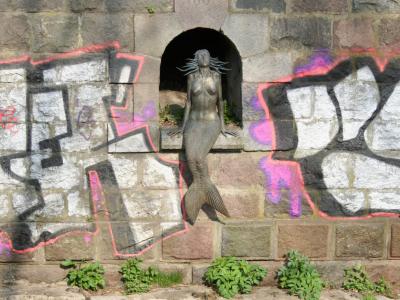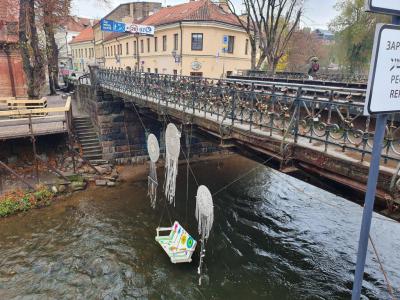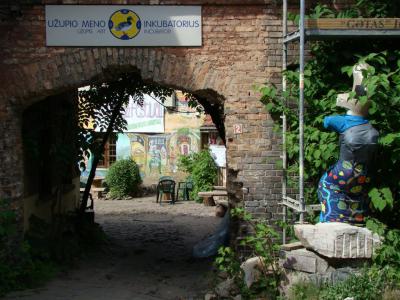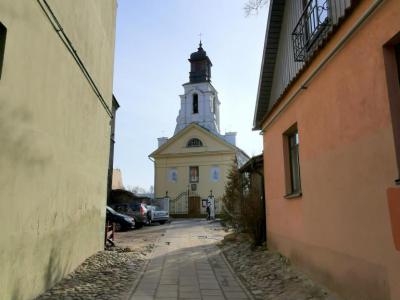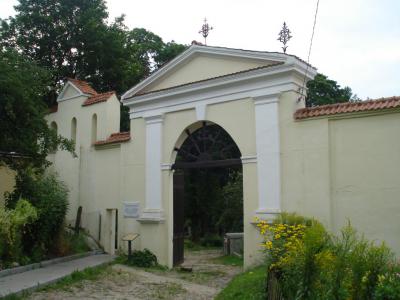Užupis District Walking Tour (Self Guided), Vilnius
A tiny isolated area and a former suburb, which now forms part of the Old Town of Vilnius, the Uzupis district is often compared, for its bohemian and laissez-faire atmosphere, to Montmartre of Paris and Freetown Christiania of Copenhagen. Similarly to the latter, in 1997, the district declared itself an independent republic; the tongue-in-cheek constitution of the self-proclaimed “republic”, translated into more than 40 languages, can be seen mounted on wall plaques along Paupio Street.
This part of Vilnius has been popular with artists since the Soviet times; many local painters and sculptors used to live or have their workshops here. Nowadays, artists’ studios are still very present, lining the narrow streets alongside art galleries, designer boutiques, hip cafes, and global eateries.
In equal measure the neighborhood is dotted with numerous street murals and installations like a bronze trumpeting angel erected on the main square, symbolizing the rebirth and artistic freedom of the quarter. Another symbol of Uzupis is a riverbank mermaid sculpture. Locals claim that if you stare into the eyes of the mermaid, prior to crossing into the republic via the Uzupis Bridge, you will never want to leave. Some say, she is the one who lured them here in the first place.
Passing down the bridge in an easterly direction, along Užupio Street, behind the gate on the right side you will see the church of St. Bartholomew, a Roman Catholic basilica built in the 17th century and rebuilt in 1824. Behind it, at a small park, where back in the day used to be a market, the street splits into Polotsko Street. From here starts the old Batory tract to Polotsk. First turn to the right leads to the Bernardine cemetery. This leafy cemetery, dated from 1810, is the burial place of numerous eminent locals and is currently listed as the Cultural Property of the Republic of Lithuania.
If you take interest in this sort of places and wish to explore the “Republic of Uzupis” in more detail, embark on this self-guided walking tour!
This part of Vilnius has been popular with artists since the Soviet times; many local painters and sculptors used to live or have their workshops here. Nowadays, artists’ studios are still very present, lining the narrow streets alongside art galleries, designer boutiques, hip cafes, and global eateries.
In equal measure the neighborhood is dotted with numerous street murals and installations like a bronze trumpeting angel erected on the main square, symbolizing the rebirth and artistic freedom of the quarter. Another symbol of Uzupis is a riverbank mermaid sculpture. Locals claim that if you stare into the eyes of the mermaid, prior to crossing into the republic via the Uzupis Bridge, you will never want to leave. Some say, she is the one who lured them here in the first place.
Passing down the bridge in an easterly direction, along Užupio Street, behind the gate on the right side you will see the church of St. Bartholomew, a Roman Catholic basilica built in the 17th century and rebuilt in 1824. Behind it, at a small park, where back in the day used to be a market, the street splits into Polotsko Street. From here starts the old Batory tract to Polotsk. First turn to the right leads to the Bernardine cemetery. This leafy cemetery, dated from 1810, is the burial place of numerous eminent locals and is currently listed as the Cultural Property of the Republic of Lithuania.
If you take interest in this sort of places and wish to explore the “Republic of Uzupis” in more detail, embark on this self-guided walking tour!
How it works: Download the app "GPSmyCity: Walks in 1K+ Cities" from Apple App Store or Google Play Store to your mobile phone or tablet. The app turns your mobile device into a personal tour guide and its built-in GPS navigation functions guide you from one tour stop to next. The app works offline, so no data plan is needed when traveling abroad.
Užupis District Walking Tour Map
Guide Name: Užupis District Walking Tour
Guide Location: Lithuania » Vilnius (See other walking tours in Vilnius)
Guide Type: Self-guided Walking Tour (Sightseeing)
# of Attractions: 7
Tour Duration: 1 Hour(s)
Travel Distance: 1.2 Km or 0.7 Miles
Author: felicity
Sight(s) Featured in This Guide:
Guide Location: Lithuania » Vilnius (See other walking tours in Vilnius)
Guide Type: Self-guided Walking Tour (Sightseeing)
# of Attractions: 7
Tour Duration: 1 Hour(s)
Travel Distance: 1.2 Km or 0.7 Miles
Author: felicity
Sight(s) Featured in This Guide:
- Uzupis Mermaid
- Bridge of Uzupis
- Art Incubator
- Tibet Square
- Uzupis Angel Statue
- St. Bartholemew the Apostle Church
- Bernardine Cemetery
1) Uzupis Mermaid
The Uzupis Mermaid is a bronze statue of a mermaid located in Old Town. The statue was crafted by artist and sculptor Romas Vilčiauskas in 2002. Tradition states that anyone who falls victims to the charms of this mermaid statue is destined to live in Uzupis forever.
Tourist can view the mermaid inside of a brick enclave looking over the Vilnia River. The best place to view the mermaid is from the Bridge of Uzupis, a love lock bridge where couples seal their love by placing a padlock along the wrought iron railing. There is also a cafe with outdoor dining that is situated with a direct view of the statue.
The bridge is a popular spot for wedding photos so don't be surprised to see happy couples getting their pictures taken with the mermaid in the background. She is a symbol of love and hope, which makes her the ideal figure to have in a photo with a happy couple.
Tourist can view the mermaid inside of a brick enclave looking over the Vilnia River. The best place to view the mermaid is from the Bridge of Uzupis, a love lock bridge where couples seal their love by placing a padlock along the wrought iron railing. There is also a cafe with outdoor dining that is situated with a direct view of the statue.
The bridge is a popular spot for wedding photos so don't be surprised to see happy couples getting their pictures taken with the mermaid in the background. She is a symbol of love and hope, which makes her the ideal figure to have in a photo with a happy couple.
2) Bridge of Uzupis
The Bridge of Uzupis is a small bridge that crosses the Vilnia River. It is one of the world's great love lock bridges, which is a spot that couples use to seal their love. A happy couple, especially those who are newly married, will place a padlock on the bridge with their names or initials written or etched in the metal.
Beneath the Bridge of Uzupis is the Uzupis Mermaid. Leaning over the bridge provides a great vantage point for this sculpture. Just before reaching the bridge, tourists will see a sign showing "Užupio Res Publica," or in English, Uzupis Free Republic. Don't forget to snap a picture.
The bridge leads from Vilnius to Uzupis, which claims to be a free republic within the city. Uzupis has its own president, government, mayor and constitution. It even has its own official currency. This was started as an April Fools' Day joke, but is now taken somewhat seriously. However, the primary purpose of Uzupis is to be a haven for art and artists.
Beneath the Bridge of Uzupis is the Uzupis Mermaid. Leaning over the bridge provides a great vantage point for this sculpture. Just before reaching the bridge, tourists will see a sign showing "Užupio Res Publica," or in English, Uzupis Free Republic. Don't forget to snap a picture.
The bridge leads from Vilnius to Uzupis, which claims to be a free republic within the city. Uzupis has its own president, government, mayor and constitution. It even has its own official currency. This was started as an April Fools' Day joke, but is now taken somewhat seriously. However, the primary purpose of Uzupis is to be a haven for art and artists.
3) Art Incubator
The Uzupis Art Incubator, often referred to simply as the Art Incubator or UMI, is the first of its kind in the Baltic states. Having been in continuous use since 2002, it is the only alternative artistic organization and arts center in the country. Though the existing incubator opened in 2002, spaces like this one have been in use since 1991. Artists would gather in an abandoned building in Uzupis to work and find inspiration.
An art incubator is a facility that provides growth for small and emerging artists. It offers low-cost work space for artists and gallery space to display the work created at the incubator and elsewhere. The Uzupis Art Incubator is an open-air gallery with art installations and sculptures located throughout. It is also a place for artists to work and socialize with little cost.
The Art Incubator is open from Monday through Friday from 9 AM to 6 PM. It is closed on all major holidays. The incubator is free and open to the public so anyone can pop-in to see what artists are working on.
An art incubator is a facility that provides growth for small and emerging artists. It offers low-cost work space for artists and gallery space to display the work created at the incubator and elsewhere. The Uzupis Art Incubator is an open-air gallery with art installations and sculptures located throughout. It is also a place for artists to work and socialize with little cost.
The Art Incubator is open from Monday through Friday from 9 AM to 6 PM. It is closed on all major holidays. The incubator is free and open to the public so anyone can pop-in to see what artists are working on.
4) Tibet Square
Tibet Square, known as Tibeto Skveras in Lithuanian, is a public square located near the Old Town in Uzupis. It was founded on an abandoned lot after the Dalai Lama visited Uzupis and was given an honorary citizenship of the symbolic free republic. The primary feature of the square is a mandala sculpture created by Rimantas Sakalauskas.
Tibet Square was opened in 2010 by Thubten Samdup, a representative of the Dalai Lama. The mandala sculpture and walking paths were added in 2013 with the blessing of the Dalai Lama. The square was officially established with a plaque, unveiled by the mayor of Vilnius, on June 21, 2017. The unveiling was organized by the Vilnius Friends of Tibet community.
It was stated by the mayor that the plaque established Vilnius as a city that is open to all people regardless of nationality, language or religion.
Tibet Square was opened in 2010 by Thubten Samdup, a representative of the Dalai Lama. The mandala sculpture and walking paths were added in 2013 with the blessing of the Dalai Lama. The square was officially established with a plaque, unveiled by the mayor of Vilnius, on June 21, 2017. The unveiling was organized by the Vilnius Friends of Tibet community.
It was stated by the mayor that the plaque established Vilnius as a city that is open to all people regardless of nationality, language or religion.
5) Uzupis Angel Statue
The Angel of Užupis is a well-known sculpture in Vilnius, that represents the revival and artistic freedom of the Užupis district. Standing on an 8.5-meter pedestal, the angel blows its horn and announces the independence of the district to the world. The sculpture is located in the Angel of Užupis Square, which is a popular destination for locals and tourists alike.
Visitors can enjoy the sunny weather while sipping water from the fountain or having a coffee from one of the nearby cafes. Additionally, the Angel of Užupis is a part of Vilnius' Talking Sculptures initiative, allowing visitors to scan the QR code at the base of the sculpture to start a conversation with the angel.
Every 1 April, the Užupis district celebrates its independence with festivities held at the foot of the Angel of Užupis. This annual event marks the district's fifth anniversary of independence and is a significant occasion for the community.
The Angel of Užupis was created in honor of Zenonas Šteinys, the patron of the Užupis district. The sculptor, Romas Vilčiauskas, was unable to complete the sculpture on time for the unveiling ceremony. As a result, an egg was placed in the sculpture's place, and the community was informed that the Angel of Užupis would soon hatch. The sculpture was finally completed in 2002, commemorating the fifth anniversary of the district's independence.
Visitors can enjoy the sunny weather while sipping water from the fountain or having a coffee from one of the nearby cafes. Additionally, the Angel of Užupis is a part of Vilnius' Talking Sculptures initiative, allowing visitors to scan the QR code at the base of the sculpture to start a conversation with the angel.
Every 1 April, the Užupis district celebrates its independence with festivities held at the foot of the Angel of Užupis. This annual event marks the district's fifth anniversary of independence and is a significant occasion for the community.
The Angel of Užupis was created in honor of Zenonas Šteinys, the patron of the Užupis district. The sculptor, Romas Vilčiauskas, was unable to complete the sculpture on time for the unveiling ceremony. As a result, an egg was placed in the sculpture's place, and the community was informed that the Angel of Užupis would soon hatch. The sculpture was finally completed in 2002, commemorating the fifth anniversary of the district's independence.
6) St. Bartholemew the Apostle Church
Saint Bartholemew the Apostle Church, known as Šv. apaštalo Baltramiejaus bažnyčia in Lithuanian, is a small, Catholic church in Uzupis. The grounds were originally home to a wooden church that belonged to the Black Augustines. That church burned in 1665.
A prayer building for monks was built in 1778 by architect Marcin Knakfus. This was demolished and the current church building was erected in 1824. The modest, brick church was built using plans from architect Karol Podczaszyński. The USSR closed the church in 1949.
The church was used as a sculpture workshop during Soviet occupation. It was gifted to the Belarusian Catholic community in 1997 to be used as a church once more. Services at the church are held in both Belarusian and Polish.
Visitors are welcome to explore the church with no entrance fee. It can be difficult to find as it is nestled among the nearby homes, restaurants and boutiques, but the tourist is rewarded with a lovely church with a colorful altar and an exquisite outdoor environment with numerous statues, reliefs and a large crucifix.
A prayer building for monks was built in 1778 by architect Marcin Knakfus. This was demolished and the current church building was erected in 1824. The modest, brick church was built using plans from architect Karol Podczaszyński. The USSR closed the church in 1949.
The church was used as a sculpture workshop during Soviet occupation. It was gifted to the Belarusian Catholic community in 1997 to be used as a church once more. Services at the church are held in both Belarusian and Polish.
Visitors are welcome to explore the church with no entrance fee. It can be difficult to find as it is nestled among the nearby homes, restaurants and boutiques, but the tourist is rewarded with a lovely church with a colorful altar and an exquisite outdoor environment with numerous statues, reliefs and a large crucifix.
7) Bernardine Cemetery
Bernardine Cemetery is a historic burial ground located in Vilnius. Established in 1810 by the Bernardine monks of the Church of St. Francis of Assisi, the cemetery covers an area of around 38,000 square meters and contains an estimated 14,000 burial sites. Situated on the embankment of the Vilnia river, it is one of the three oldest cemeteries in Vilnius.
The development of the Bernardine Cemetery was a result of the Tsarist authorities of the Russian Empire prohibiting the burial of the dead near churches. The cemetery was originally located on the outskirts of the city, in the Užupis district, just east of the city center. Columbaria were constructed on the east and west sides of the cemetery, and it was expanded in 1860.
After World War II, the cemetery was abandoned and began to deteriorate. It was closed in the 1970s and remained almost unchanged until the late 1990s, when restoration and reconstruction of its buildings and monuments, including the western columbarium, began. The eastern columbarium had almost entirely disappeared, and many of the oldest graves had sunk into the ground and become covered in moss.
In 2005, on the initiative of the Adam Mickiewicz conservation group, work on the restoration of the cemetery began, with the aim of restoring the necropolis for the two hundredth anniversary of its founding in 2010. More than a hundred historic tombstones have been renovated, with a focus on those of Polish and Lithuanian participants of the January Uprising, Home Army soldiers, and past faculty of the Stefan Batory University. Further renovations are planned for the future.
Today, the Bernardine Cemetery is an important cultural heritage. It serves as a reminder of the rich cultural and religious traditions of Vilnius, and its restoration has helped to preserve this important piece of Lithuania's history for future generations to enjoy.
The development of the Bernardine Cemetery was a result of the Tsarist authorities of the Russian Empire prohibiting the burial of the dead near churches. The cemetery was originally located on the outskirts of the city, in the Užupis district, just east of the city center. Columbaria were constructed on the east and west sides of the cemetery, and it was expanded in 1860.
After World War II, the cemetery was abandoned and began to deteriorate. It was closed in the 1970s and remained almost unchanged until the late 1990s, when restoration and reconstruction of its buildings and monuments, including the western columbarium, began. The eastern columbarium had almost entirely disappeared, and many of the oldest graves had sunk into the ground and become covered in moss.
In 2005, on the initiative of the Adam Mickiewicz conservation group, work on the restoration of the cemetery began, with the aim of restoring the necropolis for the two hundredth anniversary of its founding in 2010. More than a hundred historic tombstones have been renovated, with a focus on those of Polish and Lithuanian participants of the January Uprising, Home Army soldiers, and past faculty of the Stefan Batory University. Further renovations are planned for the future.
Today, the Bernardine Cemetery is an important cultural heritage. It serves as a reminder of the rich cultural and religious traditions of Vilnius, and its restoration has helped to preserve this important piece of Lithuania's history for future generations to enjoy.
Walking Tours in Vilnius, Lithuania
Create Your Own Walk in Vilnius
Creating your own self-guided walk in Vilnius is easy and fun. Choose the city attractions that you want to see and a walk route map will be created just for you. You can even set your hotel as the start point of the walk.
Historical Churches Tour
As the seat of the Roman Catholic Archdiocese and the Russian Orthodox Diocese of Lithuania, Vilnius boasts a wealth of gorgeous churches featuring diverse architectural styles – Gothic, Baroque, to mention but a few. Many of the local churches are historical, having witnessed centuries of events and become iconic landmarks of the Lithuanian capital.
One of the most famous temples in Vilnius... view more
Tour Duration: 1 Hour(s)
Travel Distance: 1.4 Km or 0.9 Miles
One of the most famous temples in Vilnius... view more
Tour Duration: 1 Hour(s)
Travel Distance: 1.4 Km or 0.9 Miles
Vilnius Old Town Walking Tour
Legend has it that Grand Duke Gediminas dreamed of an iron wolf howling on a hill, inspiring him to found a city that would grow into today’s Vilnius. Centuries later, in 1812, when Napoleon passed through Vilnius during his Russian campaign, he reportedly described the city as “a pearl of the north, full of charm and surprises.”
Vilnius, the capital of Lithuania, is one of Eastern... view more
Tour Duration: 2 Hour(s)
Travel Distance: 4.5 Km or 2.8 Miles
Vilnius, the capital of Lithuania, is one of Eastern... view more
Tour Duration: 2 Hour(s)
Travel Distance: 4.5 Km or 2.8 Miles
The Most Popular Cities
/ view all



